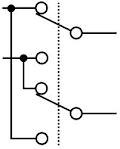07-19-2012, 11:08 PM
Hi Ian,
DPDT stands for, Double Pole, Double Throw, in other words, a switch that has two positions, and has two contacts that can have two positions. Electrically, usually wired as per below, enabling to reverse polarity on the output (right) side. The two contacts are mechanically attached, so they switch at the same time.
It is also worth investigating how your shunter differs in it's power pick up, from mainline loco's. It could be that the front axle only picks up one rail , and the rear the other, while the main line loco's have power pick up from both rails on all axles.
I think that in combination with the way your throttle is wired internally, the mainline loco's therefore cause a problem with the electronics when both sections are connected through the loco's internal wiring, as if you would put a wire bridge between lets say both positive outputs on your controller.
If you have another controller with a separate power supply, try to experiment, and use this second controller to power one section. Set both in the same direction, observing the wiring polarity, and roughly the same speed/voltage. Then see if the main line loco passes okay.
If that's the case, then it seems your controller would be the problem.
The solution then would be to use a section of track long enough to handle your largest loco between both power sections, which is isolated at both ends. This then is connected via a DPDT switch.
However the switch would need to be connected as follows:
The common of each contact to this rail, input one of each contact to go to the yard power supply, input two from the terminus section.
You can then drive your loco onto this piece of track let's say from the yard with the switch in that position. This section of track is then fed from the yard. Once the loco is on the track entirely, you flip the switch and it is then fed from the terminus section. This should enable you to have it run from one end to the other without short circuits.
Koos
DPDT stands for, Double Pole, Double Throw, in other words, a switch that has two positions, and has two contacts that can have two positions. Electrically, usually wired as per below, enabling to reverse polarity on the output (right) side. The two contacts are mechanically attached, so they switch at the same time.
It is also worth investigating how your shunter differs in it's power pick up, from mainline loco's. It could be that the front axle only picks up one rail , and the rear the other, while the main line loco's have power pick up from both rails on all axles.
I think that in combination with the way your throttle is wired internally, the mainline loco's therefore cause a problem with the electronics when both sections are connected through the loco's internal wiring, as if you would put a wire bridge between lets say both positive outputs on your controller.
If you have another controller with a separate power supply, try to experiment, and use this second controller to power one section. Set both in the same direction, observing the wiring polarity, and roughly the same speed/voltage. Then see if the main line loco passes okay.
If that's the case, then it seems your controller would be the problem.
The solution then would be to use a section of track long enough to handle your largest loco between both power sections, which is isolated at both ends. This then is connected via a DPDT switch.
However the switch would need to be connected as follows:
The common of each contact to this rail, input one of each contact to go to the yard power supply, input two from the terminus section.
You can then drive your loco onto this piece of track let's say from the yard with the switch in that position. This section of track is then fed from the yard. Once the loco is on the track entirely, you flip the switch and it is then fed from the terminus section. This should enable you to have it run from one end to the other without short circuits.
Koos
Be sure to visit my model railroad blog at <!-- m --><a class="postlink" href="http://www.namrr.blogspot.com">http://www.namrr.blogspot.com</a><!-- m -->


